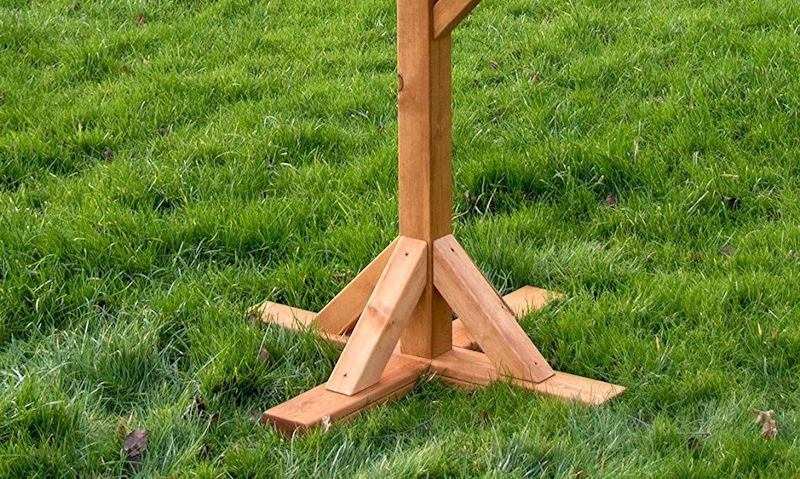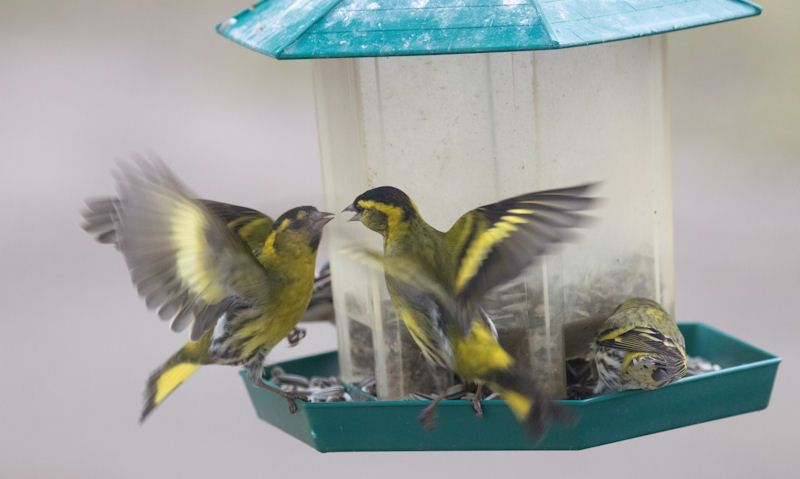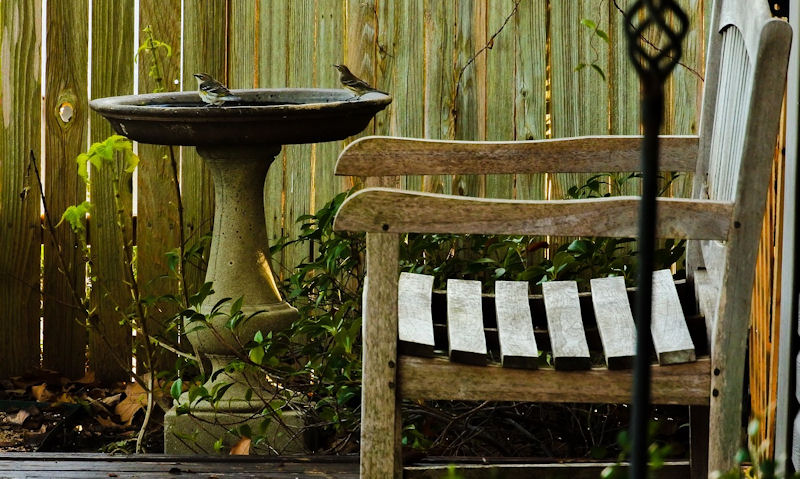How to secure bird table to ground
In need of securing a bird table to the ground? Not a problem as we've outlined working suggestions to stop that table toppling over in high winds.
To secure a bird table to the ground; make use of the makers own stabilising pegs, or make your own custom wooden stakes. It hard fixing a bird table to a patio, but not impossible as the use of drilling in masonry screws through the wooden legs, into the patio is doable.
Cheaper bird table or more an high end one, regardless, the design always risks the bird table toppling over in high winds.
You don't want this to happen even once, and for good reason. The weight of the bird table will make it crumble as it crashes onto the ground on its on weight.
If you have say a specialty bird table with a slat roof, you can guarantee those slates will not only drop off, but smash into multiple pieces.
With all that in mind, let's put a stop to it before it can ever happen to you.
We've outlined all our favourite solutions, well some are obvious and perhaps considered by you already, we've brought along our own ideas for securing a bird table to ground.
If its a lawn then a simple way would be to impale stabilisers into the ground while wrapped firmly around the bird table legs.
However, if your bird table is sited on a patio or decking, then fixing the bird table to the ground will make use of very long, masonry or wood screws.
We've offered a little advice below, before moving on to suggestions that will not make the bird table unsightly, or make the garden untidy.
Wide support base should be enough
If you're wondering how to secure a bird table to the ground, then you're likely to be in a little bother with high winds or the littlest of gusts.
Although, if your wooden bird table has not tumbled over yet and you fear it might, the chances of that happening is little to none.
And that's due to the way the manufacturer has built the support legs to have a wide support base, which should counter-act the top heavy platform fixed above.
If you haven't yet bought a bird table, then consider the width of the support base legs, the wider it is the unlikely it is to topple over.
Smaller support bases are more at risk of tipping, although if the table top is only have the width to the support legs below, then in this case, the base should be significant.
If going for a bird table for small birds only, then support base and table top should both be small, though a lightweight table carries its own issues.
Lightweight table, make it heavy
Its not for everyone but its possible your table is lighter than it really should be.
That is usually featured in cheaper wooden bird tables where its built using lighter pine or plywood, rather than the heavy duty rough sawn wood.
So what options are available to you that won't ruin the attractiveness of the bird table by piling on unsightly weights.
Well for one thing, you can make sure the bird table has lots of hanging bird feeders hanging off from the rim of the platform.
It would have to be large heavy duty feeders for it to make any difference, the feed within the feeders will also have to be kept topped up.
You could also lay down feeders under the roof bird table to further create a bit of weight.
If using the bird table as a bird feeding station for hanging off seed, peanut or fat ball feeders, distribute the weight as to not create to much weight on one side.
Secure legs to patio slab
If you're in ownership of a smaller, cheaper wooden bird table that are commercially available online, then one slab is all you need is here.
When that is not enough, then 4 slabs positioned into a big square will not only be enough for small feeders, but should be all you need to stand on a large bird table.
There's not much you need to do to prepare the patio slabs in terms of what to sit them on; such as stones, gravel or using a concrete foundation.
All you need to focus on is making sure the slabs are in keeping with your garden.
Now that you sat the bird table with its support legs all within the boundary of the one or 4 patio slabs, its time to secure it to the heavy slab foundation.
To do that you'll need to make sure the table is facing the direction you want it, which also gives you the best view well watching the birds feed.
Once its all secured to the ground, there's little going back for making corrections.
You'll now need to drill a hole through the lowest part of the support legs - so the screws are unseen and out of sight - before drilling into the stone slabs below that.
Masonry drill bit will be needed, and so will harden screws to use with wood and stone.
Bury pole attachment underground
This is quite possibly our favourite solution for securing a bird table to the ground, as its unsightly and goes unnoticed to all.
It just might be the most successful route to go down as there's little chance of the bird table toppling over, as long as the table is extended deep into the ground.
To do this you will need a 2 to 3 foot metal pole that has a corresponding drill bit on the one end. Likewise, the other end should be the part that is buried underground.
What this method requires is that you drill a hole on the underside of the wooden post the whole bird table stands on.
This drilled hole should be enough to measure up to the screw on the end of metal pole you wish to attached to the wooden post.
Once the hole in the bird table post is prepared, its time to assemble the whole thing.
Its a little tricky but all that needs to be done is begin by pushing the metal pole/spike underground well leaving it halfway out.
With help of another person, pick up the bird table well finding the drilled hole on the base, to align it with the pole inserted into the ground.
Twist the bird table around until its tightens, then finally push the bird table down to impale the metal pole deeper underground, until the support legs come to rest on the lawn surface.
Make use of manufacturer's stabilisers
Right out of the bat, there's not much to be concerned about here as the manufacturer of the bird table it belongs to will always, almost supply support pegs/stabilisers.
Its not for everyone as the support legs that are available as an add-on or accessory will not quite cut it, due to being to shallow once inserted into the ground.
If they do offer various lengths, make no mistake; the longer length is always the ones to go far and will not cause any issues well inserting into the lawn.
Measured in a way to fit with a product range or the entire series, support stabilisers are designed to fit with all bird tables from the same brand, but not necessarily.
Not always a case of one size fits all, so read up on the details carefully before committing to one as the metal pegs might not reach over the support legs on the table.
Thin, made from metal and very sturdy, you should be able to push the pegs into the ground with a little force, then leaving it be to do its job of keeping the bird table upright in the wind.
Impale tent pegs into ground
Don't get us wrong, the use of manufacturer's stabilisers should be significant enough to make sure the table stands up at all times.
Often though, and if you're buying from a manufacturer that builds high end bird tables, they might leave it to you to sort out balancing issues, if there is any.
As it happens heavy duty bird tables are designed well, so there's really no need to make use of the stabiliser from another manufacturer.
But if you do, there's always a chance the stabiliser is not compatible.
Answer to that is making use of cross-compatible tent pegs for use with bird tables that have that awkward support base design.
Its not for everyone, nor would it be compatible with all tables, but its this hook shaped tent peg that can keep the bird table support legs pushed down.
Use of tent pegs are not designed to wrap all around the wooden legs of the bird table, but rather to simply prevent the base lifting up.
Make your own wooden stakes
If you're handy with woodworking then making a set of 4 wooden stakes should not be to hard.
All that is needed is a single plank of rough sawn wood that is little more than 2 to 3 inches wide, perhaps up to 18mm thick.
To make one peg, cut up 2 pieces that are 2 feet long, with the final piece that corresponds the width of the support legs on your bird table.
We can't suggest a width here as it depends on the table in question, but try to make it a snug fit as to prevent movement well it is windy.
While using two, 2 feet long pieces, they're the pieces that are impaled underground, well raising above the ground to wrap over the bird table legs.
In addition, it might be wise to carve out a spike on the end of both sides as to make it easy to push them into the ground.
To make them last, its recommended you finish them in preserve, and then paint or stain them that matches the colour theme of your bird table.
Its not necessary fixing the support legs to the bird table with screws, though the use of 4 identical wooden support stakes will need to be made by you, well all made to fit tightly.
Drill spikes through the support legs
Only if you know what you're doing and have the skills to carry out this project, and only if you've planned it out well... but no drawings or sketches are required here.
To secure a bird table to the ground with spikes or stabilisers, whether through use of the brands/manufacturer's recommended products, it brings its problems along.
And that's with a design flaw or a unrecognised faulty product. What we're instead suggesting here is making use of said stakes/stabilisers, but making it part of the table.
What we mean is you'll need to drill a hole through all four support legs of the bird table, to then thread the stabiliser through each hole.
It will need to be a tight fit for this to work, as we want limited movement as to prevent it slowly wiggling its way out in due course.
In that case, you may as well stick to just using the manufacturer's stabilisers, so make an effort in getting this right.
What you'd be left with is one side of the stabiliser threaded through the drilled hole on the wooden support leg, well the other side is out in the open.
Though the hole should not jeopardise the stabiliser being impaled into the ground as far at it possibly needs to go. It will also depend on the bird table support leg/base.
Well some builds will allow for what we've explained, others will need to be drilled in from an angle, well its unlikely bird tables won't allow for you to do what we've suggested.
If in emergency
If you've come here in dire straits, its likely the high winds risk blowing over your expensive bird table.
So with that, get outside and move the bird table to an area that is out of the wind, or possibly place it in the shed until you've found a solution.
That solution might not be a quick fix, but rather would take a couple of days to either buy what you need, or make from wood to secure the table to the ground.
If its not possible to move such an heavy loaded bird table at this time, do one of the following, if you have supplies to hand:
- Use of sand bags - not for everyone unless you're in a flood hit area, but sand bags piled up on all 4 support legs will keep it secure
- Pile up bricks or rocks - use of spare house bricks or perhaps large rocks from the garden would be suitable for piling over the support legs
- Secure with rope - if all is not possible, use a length of rope or the washing line to tie on the bird table, to then tie up on a fixed two to three separate structures
All that is a temporary fix, and should not beconsidered indefinite as not only is it unsightly, but the items used will need to be used some other time.
To summarise
We hope we've offered you enough suggestions that one stands out as the best for your bird table securing needs.
If we were to suggest a way to secure the table to the ground, we will go for our making your own wooden stakes for custom built pegs idea - and you'll need 4 of them.
Not for everyone as not all of us have the tools or knowhow, so instead turn to the manufacturer's own stabilising pegs that will wrap around there own bird tables.
When that doesn't work, a set of tend pegs well not wrap all around the legs, but should help keep the bird table firmly fixed to the ground.
You can make use of patio slabs by using them as a foundation, well using metal fixings to secure the bird table to the slabs.
If you're here before owning a bird table, then pay close attention to the table top, as the support legs should be twice as wide, therefore the table will not ever be top heavy.


